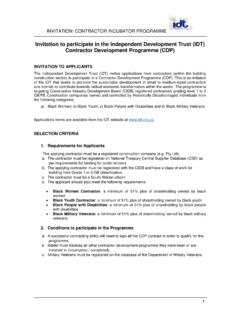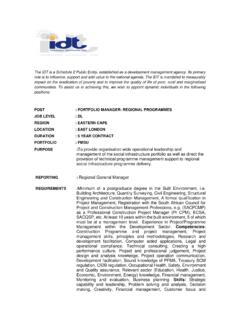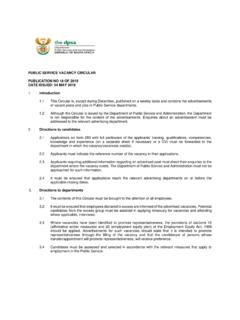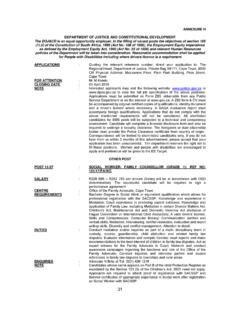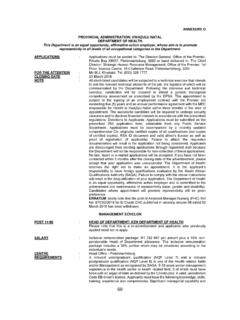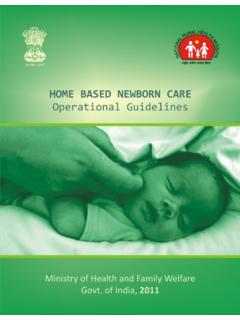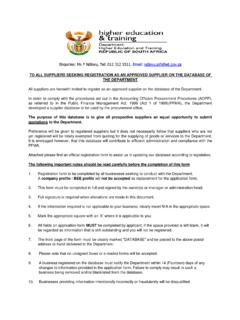Transcription of EXPANDED PUBLIC WORKS PROGRAMME NON …
1 EXPANDED PUBLIC WORKS PROGRAMME NON STATE SECTOR: PROCEDURE MANUAL Version 1(2014/15) EPWP Phase 3 2 CONTENTS PAGE 1) How to use this Manual Pg 3 2) Chapter 1: Introduction of the EPWP Non-State Sector PROGRAMME Pg 4 3) Chapter 2: Principles of the Non-State Sector EPWP Wage Subsidy Pg 10 4) Chapter 3: How the Non-State Sector EPWP Wage Subsidy WORKS Pg 14 5) Chapter 4: Branding & Training in the Non-State Sector PROGRAMME Pg 20 6) Chapter 5: Progress Reporting Pg 21 7) Chapter 6: Navigating the EPWP Web Based System Pg 29 8) Chapter 7: Records Management and Audit Requirements Pg 31 9) Chapter 8: UIF and COIDA Registration P32 10) Glossary of Terms Pg 37 11) Annexure A: EPWP NSS NGO Application guide Annexure B: EPWP Report Form Annexure C: Payment Claim Form Annexure D: Beneficiary Registration Form Annexure E: Beneficiary Agreement template with NPOs Annexure F: Ministerial Determination Annexure G: Code of Good Practice 3 How to use this Manual This manual is structured in such a way that users can easily find the relevant information they need.
2 Each chapter will focus on a specific topic. While it is useful to read the entire manual to get a good overall understanding of how the subsidy functions, users can also just use specific chapters to ensure they are able to complete specific tasks they are responsible for. Each chapter of the manual will distinguish the user of such information; the following categories of users have been identified: a- NPO s that are contracted to the NSS PROGRAMME b- Beneficiaries that have been contracted by the NPO s in the NSS PROGRAMME c- IDT & DPW PROGRAMME Managers d- Provincial staff implementing the EPWP programmes e- Service Providers who need to understand their reporting responsibilities f- Provincial Project Management Teams supporting the EPWP in the provinces and the National Project Management Team that plays an advisory role over the PROGRAMME .
3 Frequently Asked Questions (FAQs) are provided to give a better understanding of the PROGRAMME . Note regarding Version 1 EPWP Phase 3(2014/15) This is the first version of the implementation manual for the Non-State Sector EPWP Phase 3 wage subsidy issued by the National Department of PUBLIC WORKS in April 2014. 4 Chapter 1: Introduction of the EPWP Non-State Sector PROGRAMME Chapter summary: This chapter defines the EPWP Non-State Sector PROGRAMME and the objectives of the PROGRAMME . The EXPANDED PUBLIC WORKS PROGRAMME (EPWP) is one element within a broader government strategy to reduce poverty through the alleviation and reduction of unemployment. Phase I of the EXPANDED PUBLIC WORKS PROGRAMME commenced on 1 April 2004 and had the goal of creating 1 million work opportunities over its first five years.
4 Phase II (2009-2014) of the EPWP is an extension of the first phase with the following additions: The scale of the PROGRAMME has increased significantly to approximately four times its current scale. The PROGRAMME aims to provide 4, 5 million work opportunities (2 million full time equivalent jobs) over the next five years. The first phase created million work opportunities, and the target was 1 million. A new component called the Non State Sector PROGRAMME (NSS) has been introduced which uses the wage subsidy to support non state entities in providing work opportunities as part of the EPWP. The Non-State sector is to create 640 000 work opportunities in the next five (5) years. The NSS NPO PROGRAMME in EPWP Phase III (2014-2019) of the EPWP is an extension of the EPWP Phase II NSS with the following additions: 3 years multi-year contracting for NPOs Focus on support to the management of the NPO and creation of networks for the NPOs.
5 The NSS NPO PROGRAMME will not fund NPO s already supported by the Social Sector. Focus of programmes grassroots community services family support Definitions Box DPW is the Department of PUBLIC work it is the custodian of the EXPANDED PUBLIC WORKS PROGRAMME . A work opportunity is paid work created for an individual on an EPWP project for any period of time. A full time equivalent job refers to one person-year of employment. One person year is equivalent to 230 person days of work . EPWP means the EXPANDED PUBLIC WORKS PROGRAMME (2009 2014) as approved by Cabinet. The EPWP Wage Subsidy Allocation is a specifically and exclusively appropriated budgetary allocation to eligible Non- Profit Organisations to expand EPWP work for the EPWP target group by implementing EPWP programmes to achieve a targeted number of FTEs.
6 The IDT is the Independent Development Trust. 5 and social awareness and cross cutting national issues of priority that do not really have a departmental home for implementation youth development. Objective of the Non-State Sector NPO PROGRAMME In line with the NSS NPOs PROGRAMME design, the objective of the NSS NPOs PROGRAMME is as follows: To trigger and stimulate development in programmes delivered by Non- PROGRAMME Organizations (NPOs) in communities Focus on the Creation of work for the EPWP Target Group While many projects and programmes of government create work , not all of them are classified as EPWP. Given the wide variation of projects implemented by government, it is not always straightforward to distinguish between EPWP and non-EPWP projects.
7 The key characteristics of EPWP projects are listed below: a) They employ large numbers of local, low skilled, unemployed persons who are willing to work , defined as the EPWP target group b) They are highly labour intensive: a large percentage of the overall project costs are paid out in wages to the EPWP target group c) They provide a service to, or develop an asset for, the community d) Projects and programmes should not result in the displacement of existing workers or in the downgrading of existing workers employment conditions. For the purpose of distinguishing what work will qualify as EPWP work falling within the Non- State Sector EPWP it has been set that: a- work that complies with the Ministerial Determination and the Code of Good Practice for Special PUBLIC WORKS Programmes will be categorised as EPWP work qualifying for the incentive.
8 Definitions Box Beneficiary - any person actively working in the EPWP PROGRAMME Financial Year a Period of 1st April 31 March DCOG the Department of Cooperative Governance NPO Non-Profit Organisations MOA a contractual agreement signed by to entities with regards to the implementation of the NSS PROGRAMME . PARTNERSHIP structured agreement between two entities on the implementation of the PROGRAMME . PMT the project management team that plays an oversight role over the implementation of the NSS PROGRAMME . wage subsi 6 b- In addition to the above Code, it should be noted that: Government employees or permanent employees of the implementing agent will not be included in the count of the number of FTEs created The EPWP target group may not be paid below the daily wage rate upon which the subsidy is based may not be paid below R71 per person day of work in 2014/15.
9 NPO s must use the wage subsidy allocation for wage costs of beneficiaries. Non- State Sector NPO Targets The target for the Non State Sector NPO PROGRAMME over five years is: Year Overall Targets (W/O) IDT Targets NYDA Targets 2014/15 49 660 47 660 2 000 2015/16 47 765 45 765 2 000 2016/17 56 700 53 865 2 835 2017/18 56 700 53 865 2 835 2018/19 56 700 53 865 2 835 The Memorandum of Agreement (MoA) entered between the Department of PUBLIC WORKS and the IDT sets out the second phase of the Non State Sector PROGRAMME and it includes: - Developing criteria for NPO's who wish to participate in the PROGRAMME . - Appointment of NPO's - Monitoring - Reporting - Evaluation of impact - Review of the incentive model. PURPOSE The purpose of the NSS PROGRAMME is to: create an avenue where NPO's can assist government in creating income for large numbers of individuals through socially constructive activities in their local communities, 7 provide accredited training to beneficiaries so that at the end of the year beneficiaries can evolve into the second phase of the job market which would be to exist into full time jobs in line with the 6 job drivers of governments new growth path and Encouraging municipalities in utilizing the human capacity of NPO s funded by the NSS PROGRAMME in municipal IDP projects aimed at developing local communities.
10 SUPPORT PARTNERSHIP INTERVENTIONS The daily wage in some NGO s will be used as a supplement to the wages of beneficiaries. As long as private sector, sector departments or municipalities continue to fund the resources of the PROGRAMME DPW complements the work of the NPO by providing the wage subsidy. This will continue to build a co-funding approach in which national, provincial, local government and private sector work together in the creation of work opportunities. THE ROLE OF THE PROJECT MANAGEMENT TEAM The Non-State Sector is a key component of the second phase of the EPWP and is led by the Minister of PUBLIC WORKS . It is funded from the overall wage subsidy allocation provided to DPW on its budget vote. The Non-State Sector PROGRAMME is managed by DPW with oversight provided by the Project Management Team (PMT).



